
The Lafayette Lamb House is an historic building located in Clinton, Iowa, United States. It was listed on the National Register of Historic Places in 1979.
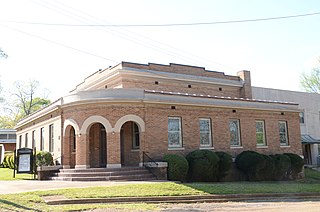
The First Methodist Church is a historic church at the junction of Chestnut and 4th Streets, NW corner in Lewisville, Arkansas. The single story brick building was designed by Witt, Seibert & Company of Texarkana and built in 1913. It is distinctive as one of the only church buildings to survive from Lewisville's period of economic prosperity during the lumber boom, and as an Akron Plan design with Classical Revival features.
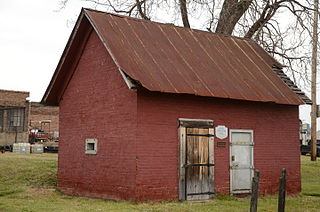
The Gurdon Jail is a historic city jail at West Joslyn and Front Streets in Gurdon, Arkansas. The single-story brick building, which contains two cells, was built in 1907 by the co-owner of the local brick company, M.D. Lowe. It is the only such structure in the city, and is one of a few surviving buildings from Gurdon's boom time as a lumber town in the early 20th century.

The P. D. Burton House is a historic house at 305 Chestnut Street in Lewisville, Arkansas. The two-story wood frame house was built in 1916 for Percy Duffield Burtun, and is an excellent local example of American Craftsman architecture. Its features include a jerkinhead roof with exposed rafter ends, and a porch supported by large brick piers and large brackets.
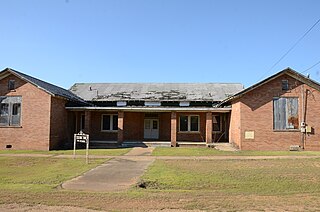
The Lafayette County Training School is a historic school building at 1046 Berry Street, on the former campus of Ellis High School in Stamps, Arkansas. It is a single-story brick building with gable roof, built in 1929 with assistance from the Rosenwald Fund. It is laid out in the shape of an H, and houses six classrooms in the side wings, with an office, library, and auditorium in the center. It is the only surviving Rosenwald School in Lafayette County. It served the area's African-American student population until 1969, when the county schools were integrated. It thereafter served as an integrated middle school until 1975, and for a time as a daycare center afterward.
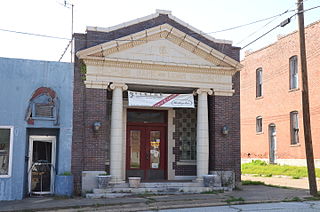
The Peoples Bank and Loan Building is a historic commercial building at the southwest corner of Spruce and 3rd Streets in Lewisville, Arkansas. The single-story masonry building was designed by the Texarkana firm of Witt, Seibert & Company and built in 1915, during Lafayette County's timber boom years. It is one of the few commercial buildings in the county to survive from that period, and is a fine local example of Classical Revival architecture.
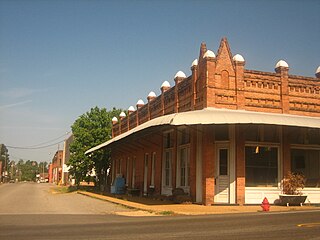
The King–Whatley Building is a historic commercial building at the northwest corner of Maple and 2nd Streets in Lewisville, Arkansas. The single story brick building was built c. 1902 for the First National Bank of Lewisville, and later house legal offices and title companies that played an important role in the area's land development in the early decades of the 20th century. The building has a distinctive curved canopy, and a parapet rising above the flat roof which is studded with brick piers topped by rounded concrete caps.

The Lafayette County Courthouse occupies a city block in the heart of Lewisville, Arkansas, the seat of Lafayette County. It is a two-story brick building with Art Deco styling, built in 1940-42 as a Works Progress Administration project. Although it has a basically rectangular plan, it has a stepped visual appearance, with single- and two-story projections. Ornamentation of the buff brick surfaces is minimal. It is the county's finest Art Deco structure.

The Ashdown Commercial Historic District encompasses part of the historic commercial heart of Ashdown, the county seat of Little River County, Arkansas. This area was developed primarily between 1905 and 1945, and represents the city's growth during that time as a cotton and lumber center. It covers a roughly two-block area bounded on the west by an alley west of East Main Street, on the north by Keller Street, on the east by Whitaker Street, and on the south by North Constitution Street. Prominent early buildings in the district include the R. M. Price Building, a large two-story brick building built 1905, the 1915 Dixie Theater, and the 1905 Little River News building at 45A E. Main Street. Stylistically distinctive is the 1947 Williams Theater at 360 Keller Street, which is the only Art Deco building in the area.

The Hayes Hardware Store is a historic commercial building at 314 DeQueen Street in downtown De Queen, Arkansas. It is a brick 1-1/2 story structure, sharing party walls with adjoining buildings on either side. Its brick facade is divided into two three-bay sections, with brick pilasters at the ends and in the center. Above the first-floor storefront windows is a clerestory level, above which is an attic space, where each of the six bays has a small oculus window. Above the second and fifth bays is a rounded arch. The building was built c. 1900 by the Dierks Lumber and Coal Company, which built the De Queen and Eastern Railroad, making the city the commercial center of Sevier County. The building was acquired in 1908 by the Hayes Hardware Company.

The Nashville Commercial Historic District encompasses much of the historic downtown commercial area of Nashville, Arkansas, and the major commercial center in Howard County. It is centered at the junction of Main and Howard Streets, extending eastward along East Howard, and north and south along Main Street for about one block. Most of the buildings in the district are tall single-story brick structures, some covered in stucco. They were built between about 1895 and the 1930s, with a smaller number appearing later. The area's economic activity was driven first by the arrival of the railroad, which defined the layout of the town, and then by the growth of lumber and agriculture in the region. The oldest building in the district is 203 North Main, built c. 1895 with modest Romanesque Revival styling.

The Chicago Mill Company Office Building is a historic commercial building at 129 North Washington Street in West Helena, Arkansas. It is a single-story wood frame structure, whose Craftsman styling includes broad eaves and a wraparound porch supported by square columns. Built c. 1920, it housed the local offices of the Chicago Mill Company, one of the largest lumber concerns to operate in West Helena when that business was booming in the 1920s and 1930s. It is one of the few commercial buildings in West Helena to survive from that time.

The Marianna Commercial Historic District encompasses the historic civic and commercial heart of Marianna, Arkansas, the county seat of Lee County. The district is focused on two blocks of Main Street and two blocks of Poplar Street, which cross at the northwest corner of Court Square, a city park in which the Gen. Robert E. Lee Monument is found, and extends south to include a few buildings on Liberty Street. The city was founded in 1870, and its economy developed around cotton and lumber, which were delivered to market by the L'Anguille River, a tributary of the Mississippi River. The downtown developed a short distance west of the city's boat landing. Its first brick buildings were built in the 1870s, although the oldest to survive now date to the 1880s, including the elaborate Italianate Hayes & Drake building at 38 South Poplar. Court Square Park has long been a major community meeting point, and is faced by the Lee County Courthouse. The district includes seventy buildings, of which forty eight are historically significant.
The Stuttgart Commercial Historic District encompasses a portion of the commercial center of Stuttgart, Arkansas. The district extends along Main Street between 1st and 6th Streets, and includes a few buildings on the adjacent numbered streets as well as Maple and College Streets, which parallel Main to the west and east, respectively. The majority of the district's 76 buildings were built between about 1900 and 1920, and are brick commercial structures one or two stories in height. Notable among these buildings are the Riceland Hotel, the Standard Ice Company Building, and the county courthouse.

The Lepanto Commercial Historic District encompasses the traditional commercial heart of the small city of Lepanto, Arkansas. The district includes one block of Greenwood Avenue between Berry and Holmes Streets, and portions of two more blocks at either end, as well as two blocks of Berry Street, with a few buildings on adjacent streets. Lepanto was founded in 1903, but its surviving commercial architecture only dates as far back as c. 1915, when the Portis Company cotton gin was built at the eastern end of the district. Other early buildings include the triangular {{circa|1920} Arlington Light and Power building at 320 Greenwood, and the unusual Barton's of Lepanto building at 111 Berny Street, built as a wood frame lumber yard office {{circa|1920); its walls were bricked in 1955 when it was converted to a hardware store.

The Three States Lumber Company Mill Powerhouse, also known as the Burdette Plantation Company Store, is a historic industrial site on Old Mill Road in Burdette, Arkansas. The only surviving element of what was once a much larger sawmill, the powerhouse is a two-part structure built in 1909 to provide electrical power to the Three States Lumber Company. The northern part of the building is a two-story brick structure with a gable roof, while the southern part is a single-story shed-roof concrete structure, which includes the remnants of a smokestack. The Three States company ran a large sawmill on this site between 1906 and 1922, removing most of the structures when its operations shut down. The property was converted into a plantation when the company moved out, and this building became the company store.

The Poinsett Lumber and Manufacturing Company Manager's House, also known locally as the Singer Mansion, is a historic house at 512 Poinsett Avenue in Trumann, Arkansas. It is a single-story structure, with a varied roof line, and multiple exterior sheathing materials, including brick and stucco with false half-timbering typical of the Tudor Revival style, and recently applied modern siding. The house was designed by Edwin B. Phillips and built in 1935 for the Poinsett Lumber Company to house its senior on-site manager. It is, despite the modern siding, the only Tudor Revival building in Trumann, and the only surviving residence associated with the Poinsett Lumber Company, a major area employer in the first half of the 20th century.
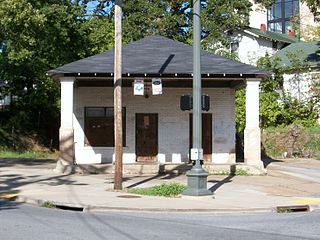
The Magnolia Company Filling Station is a historic automotive service station building at 492 West Lafayette Street in Fayetteville, Arkansas. It is a small single-story white hip-roofed brick building, with a portico, supported by brick piers, extending over the area where the fuel pumps were originally located. The building has a center entrance, with a single sash window to the left, and a large window to the right. Built in 1925, it is one of the region's oldest surviving gas stations, and, according to its National Register nomination in 1978 was the only one then known to have been built by the Magnolia Company and to still be surviving.
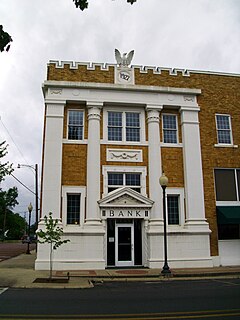
The Warren Commercial Historic District encompasses the historic commercial heart of Warren, Arkansas. The district's northern end is focused on the Bradley County Courthouse and Clerk's Office, and extends down Main Street to Church Street, with branches along cross streets and roads radiating from the courthouse square. This area was developed beginning in the 1840s, but its oldest buildings date to the 1890s, primarily brick commercial buildings. Of architectural note are the courthouse, a Beaux Arts structure built in 1903, and the Classical Revival Warren Bank building (1927).

The Gulf Oil Company Filling Station is a historic automotive service station building at 131 Main Street in Stamps, Arkansas. It is a single-story brick building, with a portico, supported by brick piers, extending over the area where the fuel pumps were originally located. The portico extends from the portion of the building housing what originally served as the station office, with two automotive service bays to its right. The station was built about 1930, to a corporate design introduced by Gulf Oil in the 1910s, and is painted in that company's colors: white, blue, and orange.





















